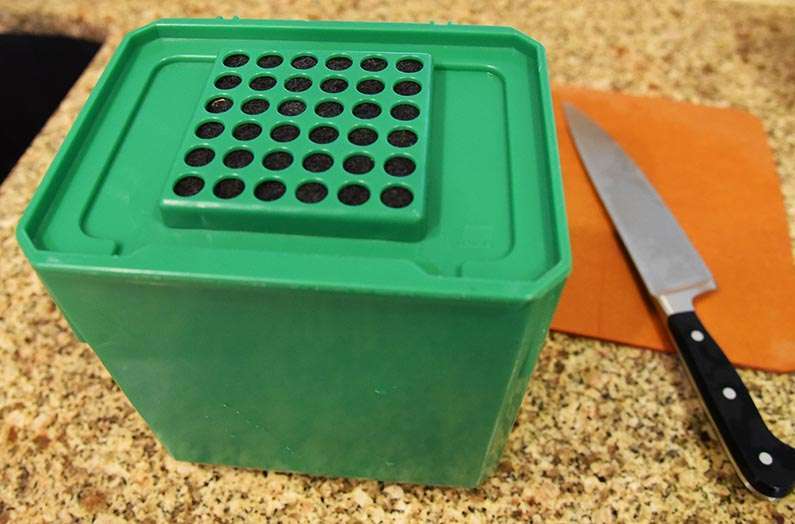I compost my kitchen scraps and want to share my tips for easy composting. Not only is composting good for my garden, it reduces the garbage I send to the landfill. Many landfills are rapidly filling up, and about a third of the waste is compostable material. My composted kitchen scraps create rich humus that adds nutrients to the soil which, in turn, feed my vegetable plants. The microscopic organisms that break down the scraps help prevent diseases and aerate the soil. Composting replaces the need for chemical fertilizers.
I use a small one gallon container that has a charcoal filter the keeps unpleasant odors from wafting through my kitchen. I purchased mine many years ago and can’t find the exact model anymore. However, Amazon has many options.
Most all vegetable and fruit scraps can be composted. I don’t compost avocado seeds because they tend to sprout. Non-organic banana peels may have pesticide residue, so I don’t compost them either. However, organic banana peels are okay. Coffee grounds and tea leaves compost easily and add nitrogen to the soil. Nitrogen is a fertilizer that is necessary for plant growth and the development of healthy foliage. Crushed egg shells add carbon which is a food source for micro-organisms and improves soil stability. Do not compost dairy or meat products including bones or fish scraps as they will attract pests and rodents.
As you clean your fruits and vegetable, put your scraps in your compost container. Add your coffee grounds, tea leaves, and crushed egg shells. After a few days, you’ll see that some of the scraps are decomposing and turning into a liquid. You also might see fuzzy mold. That’s okay. The mold is harmless.

When your container is full or about once a week, dig a hole in your garden large enough to hold the contents of your container. I usually put my compost in my vegetable garden, but occasionally put the scraps in my flower garden. I don’t pick the same spot twice in a row. However, the scraps decompose very fast in the garden, so I’m able to use the same spot again when I’ve run out of unused space.

Once you’ve dug your hole, dump your kitchen scraps into it. I compress the scraps down into the hole with my trowel.

Cover the scraps with dirt. Be sure they are completely covered. Don’t leave any scraps visible. Pack down the dirt to make it seal in the scraps better. The dirt seals in any odors that might attract animals or pests.

That’s it. That’s all you need to do for easy composting. Your plants will thrive on the natural fertilizer. In addition, you’re helping the environment by keeping your kitchen scraps out of the landfill. As I saw what I put into my compost container, I became more aware of food scraps that I threw away in the past. So, now I’m using more of my scraps in soups or other dishes and wasting even less food. Plus, the earth worms love it. When I dig my holes, I see lots of wiggly worms indicating that the soil is healthy.
I hope you’re enjoying your garden this fall as much I am. I have some pepper plants that are loaded with peppers and am thinking about making some hot pepper jelly. If you have a good recipe for it, please send it my way as I’ve never made hot pepper jelly before and am looking for a recipe to use. I’d also like to hear about the produce you’re harvesting from your garden and any garden tips you have to share.
Cheers to a Happy Fall!

